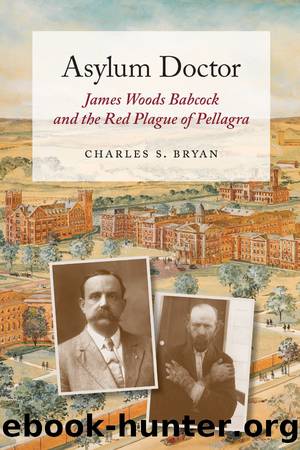Asylum Doctor by Charles S. Bryan

Author:Charles S. Bryan [Bryan, Charles S.]
Language: eng
Format: epub
Tags: Biography & Autobiography, Medical (Incl. Patients), Medical, History, Social Science, Disease & Health Issues
ISBN: 9781611174915
Google: bgLQBgAAQBAJ
Publisher: Univ of South Carolina Press
Published: 2014-05-27T04:04:43+00:00
Governor Coleman Livingston Blease (1868â1942) pressured Babcock to dismiss his talented and capable young assistant Dr. Eleanora Bennette Saunders, leading to Babcockâs resignation.
Courtesy: South Caroliniana Library, University of South Carolina, Columbia, S.C.
Blease became governor with âthe full intention of removing Dr. Babcock from the State Hospital for the Insane.â He felt Babcock had been âa traitor to my friend, Col. James H. Tillman.â All that changed the day Babcock invited him to ride out to State Park. Heading out of Columbia in a buggy on a Sunday morning, Babcock disclosed circumstances that changed Bleaseâs perspective on Babcockâs role in James Tillmanâs trial for the murder of newspaper editor N. G. Gonzales. Babcock offered his resignation but Blease refused to accept it.36 They established a working relationship, indeed a good working relationship. In November 1911, for example, Blease gave a welcoming address at one of Babcockâs pellagra clinics, told how Babcock had given him statistics, and offered to help.37 Babcock on several occasions consulted the governor about problems at the asylum. Each time Blease responded immediately. On one occasion Babcock learned the nurses were about to strike, went to the Executive Mansion, and found the governor at breakfast. Blease took one sip of coffee and headed to the asylum, reassured the nurses, and urged them to stay at their posts.38
Blease had reasons to keep the superintendent beyond their new personal relationship. Dismissing Babcock carried a political price. The superintendent was popular among the general public and with many legislators. Babcock supporters included Blease confidants, such as Colonel Elbert Aull from Newberry, Bleaseâs lifelong friend and former schoolteacher,39 and Dr. Robert Wilson Jr., who in 1913 saw the governor often during his successful campaign to transfer the endangered Medical College of the State of South Carolina to state ownership.40 Finally, Babcockâs performance by at least one Blease criterionâmaking do on a limited budget, thereby helping keep taxes lowâwas superb.
But Blease also had had reasons to rein in the superintendent. The governor like many public men prized power above nearly everything else. He sought power, used power, and retaliated against those who threatened his power. He wanted Babcock like others to feel the weight of his authority. Also, more than most governors in South Carolina history, Blease favored small government, minimal interference in peopleâs lives, and little aid for the disadvantaged. In a later era he would probably be called a libertarian. He took a dim view of the financial burden that State Park would impose on taxpayers mainly for the benefit of blacks.
Although Bleaseâs tours of State Park with Babcock were pleasant, the governor began to devise his own schemeââplanâ would perhaps be too generousâfor the stateâs mentally ill. He would sell most of the âlittle sandy bottom landâ with its scrub oaks and loblolly pines, which in his opinion had been bought at exorbitant price âunder the pretense of benefiting poor insane people.â He would keep the nearly finished first cottage at State Park, but would âtake that place out there
Download
This site does not store any files on its server. We only index and link to content provided by other sites. Please contact the content providers to delete copyright contents if any and email us, we'll remove relevant links or contents immediately.
Psychiatry and Racial Liberalism in Harlem, 1936-1968 by Dennis A. Doyle(122)
Doctors of Deception : What They Don't Want You to Know About Shock Treatment by Linda Andre(104)
The Daly Dish Bold Food Made Good by Daly Gina;Daly Karol;(101)
The Stem Cell Hope by Alice Park(95)
The Cure for Women by Lydia Reeder(92)
Doctoring Freedom by Gretchen Long(90)
How Not to Study a Disease by Karl Herrup(89)
Pharmaceutical Medicine and Translational Clinical Research by Vohora Divya;Singh Gursharan; & Gursharan Singh(89)
9781836207139 by Miguel Gonzalez(89)
Tissue Engineering: Principles and Practices by Fisher John P(88)
Proper People: Early Asylum Life in the Words of Those Who Were There by David Scrimgeour(84)
How We Became Sensorimotor: Movement, Measurement, Sensation by Mark Paterson(83)
A Secret Mind by Kaye Kelly(83)
Medical Applications of Beta-Glucan by Gürünlü Betül;(76)
Summary and Analysis of Patient H.M. by Worth Books(74)
Mary Putnam Jacobi and the Politics of Medicine in Nineteenth-Century America by Carla Bittel(73)
Women Doctors in War by Judith Bellafaire; Mercedes Herrera Graf(71)
The Changing Face of Medicine : Women Doctors and the Evolution of Health Care in America by Ann K. Boulis; Jerry A. Jacobs(70)
Mixing Medicines by Griffin Clare;(67)
